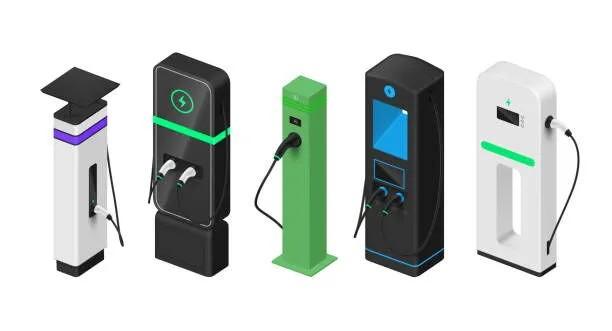إعلان مُمول
Understanding and Reducing the Costs of EV Charging Stations

Understanding and Reducing the Costs of EV Charging Stations
As electric vehicles (EVs) gain popularity, the demand for EV charging infrastructure is growing rapidly. Businesses, government entities, and property owners are increasingly considering installing EV charging stations. However, managing costs is critical to ensure these investments remain viable over the long term. This article breaks down the main cost components of EV charging stations and offers practical tips to reduce expenses, making EV charging more affordable and accessible.
Key Cost Components of China EV Charging Stations
Installing EV charging stations involves several cost categories that collectively determine the total investment:
1. Installation Costs
Installation expenses vary based on site specifics such as location, electrical system requirements, and labor. Costs can include wiring, conduit installation, trenching, and sometimes transformer upgrades. Complex sites, especially older or remote locations, often incur higher installation fees.
2. Hardware Costs
The charger hardware itself varies widely in price depending on type and brand. Level 1 chargers (slow, residential use) are the most affordable. Level 2 chargers, commonly used in commercial and public settings, are more expensive. DC fast chargers (Level 3) designed for quick charging in high-traffic areas come with the highest price tag.
3. Operating Costs
Ongoing operating expenses include software licensing, network fees, and transaction processing for connected chargers. Networked stations allow real-time monitoring, pricing control, and maintenance alerts but add to operational costs.
4. Maintenance Costs
Routine maintenance is essential for reliability and reducing downtime. This includes inspections, repairs, and replacing worn components. While less expensive than installation, maintenance is a recurring cost that must be budgeted.
5. Energy Costs
Electricity consumption is a significant ongoing expense. High-usage stations may face peak demand charges during periods of heavy power draw, increasing overall energy bills. Effective energy management is key to controlling these costs.
Strategies to Lower EV Charging Station Costs
Reducing EV charging costs begins with careful planning and informed decision-making throughout the installation and operation process. Consider the following cost-saving approaches:
1. Locate Stations Close to Power Sources
Position charging stations near existing electrical infrastructure to reduce wiring and trenching needs. This minimizes installation complexity and costs while limiting disruption to the site.
2. Select the Right Charger Types
Match charger types to usage patterns. Level 2 chargers work well in places where vehicles stay parked longer, such as offices or residential buildings. Fast chargers suit high-traffic locations needing rapid turnaround. Choosing the appropriate chargers helps optimize costs and user satisfaction.
3. Use Load Management Solutions
Dynamic load management balances electricity demand across multiple chargers, reducing the need for costly electrical upgrades and minimizing demand charges. This approach enhances energy efficiency and keeps utility costs predictable.
4. Prepare Make-Ready Parking Spaces for Future Expansion
Install wiring and conduit for additional charging spots during initial construction without deploying chargers immediately. This “make-ready” infrastructure allows for quick, cost-effective upgrades as EV adoption grows.
5. Take Advantage of Government Incentives
Many federal, state, and local programs offer grants, rebates, or tax credits to support EV infrastructure. Leveraging these incentives can substantially reduce upfront hardware and installation costs.
6. Implement Smart Energy Management Systems
Use energy management tools to monitor and optimize power use in real time. Adjusting charging schedules to off-peak hours and controlling peak demand lowers energy bills and operational costs.
7. Conduct Regular Maintenance
Routine servicing prevents breakdowns and costly emergency repairs. Keeping chargers in good condition improves uptime and user experience while extending equipment life.
8. Explore Revenue-Generating Opportunities
Charging fees based on time, energy consumption, or flat rates can offset costs. Some stations also generate income through digital advertising, helping cover operational and maintenance expenses.
Conclusion
Managing the costs of EV charging stations requires a strategic combination of smart planning, technology selection, and financial incentives. From installation and hardware to ongoing energy use and maintenance, each cost factor presents opportunities to save. By placing chargers near power sources, choosing suitable equipment, leveraging incentives, and employing smart energy management, businesses and property owners can build affordable, sustainable charging networks. These steps not only reduce expenses but also create a future-ready infrastructure that supports the expanding EV market. Early adopters of efficient, cost-effective charging solutions will be well positioned to meet growing demand while maintaining financial viability.Know more about Google SEO Directory
الأقسام
إقرأ المزيد
➲-➲ Product Name ➺ Natural Bliss CBD Gummies ➲-➲ Composition ➺ Natural Organic Compound ➲-➲ Side-Effects ➺ NA ➲-➲ Availability ➺ Online ➲-➲ Ingredients ➺ 100 % Natural ➪➪➪ Official Website (Sale Is Live) ➺➺➺Click Here ➢➢ Visit The Official Website To Get Your Bottle Now➢➢ ➢➢ Visit The Official...

The tuberculosis vaccine market comprises products that help in the prevention of tuberculosis infection caused by bacteria called Mycobacterium tuberculosis which usually affects the lungs. Tuberculosis vaccines are an important part of the global public health strategy to control and eventually eliminate the deadly disease. The current vaccine used is Bacille Calmette Guérin (BCG)...



